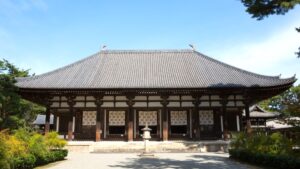Kyoto Imperial Palace, Successive Emperor's Residence
The Heian-kyo had been the center of the nation where the successive emperors resided for over 1200 years since the capital relocation from Nara in 794 by the 50th Emperor Kanmu until 1869 when Emperor Meiji moved to Tokyo, one year after the Meiji Restoration. The highlight is the beautiful Shishinden Hall with its cypress […]
Kiyomizu-dera Temple, Kannon Brought Victory to a Noble Warrior, Tamuramaro
Kiyomizu-dera Temple recognized as one of the Historic Monuments of Ancient Kyoto and a World Cultural Heritage site, was established halfway up Mt. Otowa in 778, merely six years before the capital relocation from Nara’s Heijo-kyo. The main image is the Eleven-headed Thousand-armed Kannon Bodhisattva, revered for aiding people from difficulties. The most enchanting feature […]
Toshodaiji Temple, Ganjin brought precepts to Japan after five failed journeys
Toshodaiji Temple, a UNESCO World Heritage Site, was founded by Ganjin or Jianzhen (668-763, 鑑真) in 759 as a center for Buddhist training when Asuka(now Nara) was Japan’s capital. In 733, during the region of the 45th Emperor Shomu (701-756, 聖武天皇), two young Japanese monks named Yoei and Fusho embarked on a mission to the […]
The History of Hachiman Deity worshipped at Usa Jingu Shrine, protecting Japan and Samurai
Usa Jingu is the head shrine of approximately 460,000 Hachimangu shrines, out of a total of 110,000 shrines in Japan. This makes it the largest number in Japan. The three major Hachimangu shrines are Usa Jingu in Kyushu, Hakozakigu in Kyushu, and Iwashimizu Hachimangu in Kyoto. The deity worshipped at Usa Jingu Shrine, Hachiman Omikami, […]
Fushimi Inari Taisha Shrine covered by over 5,000 vermillion torii gates
Fushimi Inari Taisha Shrine is one of the most notable Shinto shrines located at the foot of Mount Inari, which is considered sacred as a whole, in southern Kyoto. It is the head of over 30,000 Inari shrines across the nation that are prayed to for a good harvest. A grain deity named Ukano-mitama, also […]
Todaiji Temple and Great Buddha, Emperor Shomu's dearest wish to settle a smallpox epidemic comparable to the plague in medieval Europe
Todaiji Temple - a World Heritage Site - is enormous, measuring 48.74m high, 50m deep, and 57m wide. It houses Japan's most giant bronze statue, the Great Buddha - a national treasure. The original size of the Great Buddha Hall was about 1.5 times that of the present one. Two gigantic seven-story pagodas, nearly 100 […]






